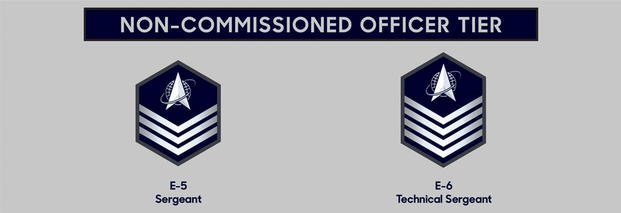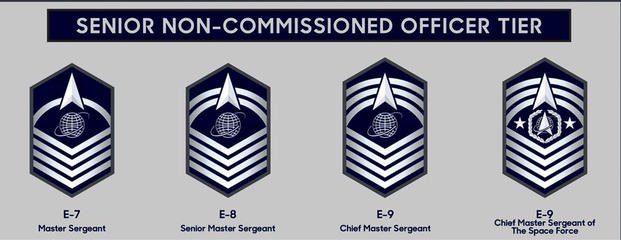Space Force enlisted ranks largely mirror those of the Air Force. On Jan. 29, 2021, Space Force officials announced the official rank naming structure for Guardians, as Space Force members are known. On Sept. 20, 2021, they released updated insignia for enlisted Guardians.
The U.S. Space Force is the sixth independent U.S. military service branch, tasked with missions and operations in the rapidly evolving space domain.
Read Next: Learn more about Space Force
Like the Air Force, enlisted Space Force ranks are broken down into three levels: specialist (E-1 through E-4), noncommissioned officers (E-5 and E-6), and senior noncommissioned officers (E-7 through E-9).
- Specialist Ranks (E-1 through E-4)
- Noncommissioned Officer Ranks (E-5 and E-6)
- Senior Noncommissioned Officer Ranks (E-7 through E-9)
- Chief Master Sergeant of the Space Force (E-9S)

Space Force Ranks: Specialist (E-1 through E-4)
As of 2020 new members of the Space Force are not pulled in from the most junior ranks in and just out of Air Force basic training. Instead, they are recruited from airmen in the Air Force's space systems operations (1C6) career field.
Specialist 1 (E-1)
As of 2020, new members of the Space Force have attended and graduated from Air Force basic training as regular members of the Air Force. After ascending into the Space Force they are known as specialist, with an official designation of Specialist 1 (E-1).
Typically, promotions to E-2 are automatic as long as the service's standards for performance and behavior are met. The only requirement for Air Force advancement is 6 months time in grade (TIG) and time in service (TIS).
Specialist 2 (E-2)
The rank of Specialist 2 brings with it the responsibility of adjusting to the way of military life, and becoming proficient in their Space Force occupational specialty. For the Space Force, that means entering training for space systems operations (1C6) career field after graduation from Air Force basic training.
Specialist 3 (E-3)
Specialist 3 Guardians are considered to be fully adjusted to the Space Force and military life, and their duties focus on efficiently and effectively carrying out their assignments and honing their job skills.
Specialist 2 Guardians must have at least 10 months time in grade before being promoted to Specialist 3. In the Air Force, the average time in service before promotion to Airman First Class is 16 months.
Specialist 4 (E-4)
The rank of Specialist 4 is a transition period from journeyman to noncommissioned officer (NCO). Specialist 4 Guardians in the Space Force and Senior Airmen in the Air Force are expected to conduct themselves in accordance with established standards, providing a positive influence and example for their subordinates and peers alike. Senior Airmen are to present the image of competence, integrity and pride.
Moving up the ranks: The Space Force requires for Specialist 3 to have 28 months time in grade (TIG), or 36 months TIS and 20 months TIG. In the Air Force, the average service-wide active-duty time for advancement to the rank of Senior Airman (or Specialist 4 in the Space Force) is three years.

Space Force Ranks: Noncommissioned Officer (NCO) (E-5 and E-6)
Space Force enlisted members E-5 and E-6 are referred to as NCOs. Space Force NCOs are expected to exemplify personal integrity, loyalty, leadership, dedication and devotion to duty including upholding Space Force policies, traditions, and standards.
Space Force NCOs and Senior NCOs are promoted based on the Weighted Airman Promotion System (WAPS) used by the Air Force. Airmen with the proper TIS/TIG/Skill Level and commander's recommendation compete for promotion based on their "WAPS Points" within the current Air Force specialty code that feeds to Space Force.
The WAPS promotion points are derived from a system which gives points for Promotion Fitness Examination (PFE), Specialty Knowledge Test (SKT), Medals and Awards, Time-in-Grade (TIG)/Time-in-Service (TIS) and Performance Evaluations. Those with the highest points get promoted first.
Sergeant (E-5)
The Sergeant (Sgt.) is the first level of the noncommissioned officer (NCO) ranks in the Space Force. The Sergeant is considered a craftsman with specific NCO supervisory responsibilities and may hold either a 5- (journeyman) or 7- (craftsman) skill level. Additionally the Sergeant must continuously strive to further their development as technicians and supervisors. In the Air Force the average service-wide active-duty time for promotion to the rank of Staff Sergeant, the Air Force equivalent for the Space Force Sergeant, is over four years.
In the Air Force, promotion to E-5 requires three years Time-in-Serve (TIS) and six months Time-in-Grade (TIG). In addition, airmen must achieve a 5-skill level, compete in the "Weighted Airman Promotion System," or WAPS and complete the Airman Leadership School in-residence prior to assuming the rank of SSgt.
Technical Sergeant (E-6)
The Technical Sergeant (TSgt.) is the second level of the noncommissioned officer (NCO) ranks in the Space Force. Technical Sergeants are qualified to perform highly complex technical duties in addition to providing supervision. In addition, they're responsible for the career development of each subordinate under their supervision.
It is the Technical Sergeant's responsibility to ensure that all enlisted personnel have the tools, training and support they need to achieve maximum performance and accomplish total mission effectiveness. In the Air Force, the average active-duty time service-wide for promotion to the rank of Technical Sergeant is 12 years.
The promotion process for Tech Sergeant is identical to the process for promotion to Staff Sergeant, except for the minimum requirements of 5 years Time-in-Serve (TIS) and 23 months Time-in-Grade (TIG), in addition to achieving a 7-skill level.

Space Force Senior Noncommissioned Officer (SNCO) Ranks (E-7 through E-9)
Space Force enlisted members E-7 and above are referred to as SNCOs. Space Force SNCOs are expected to set the highest standards of personal integrity, loyalty, leadership, dedication and devotion to duty including upholding policies, traditions and standards.
Like the NCO ranks, senior NCOs are rated by their "Skill Levels." The following is a breakdown of the Space Force's SNCO required skill levels:
- 7-Level: Supervisor. Technical Sergeant (E-6) to Master Sergeant (E-7)
- 9-Level: Manager. Skill-level assigned to E-8s and E-9s.
Master Sergeant (E-7)
The Master Sergeant (MSgt.) functions primarily as a craftsman while holding more advanced leadership positions. Master Sergeants hold a 7-skill level. This rank carries significantly increased responsibilities and requires a broad technical and managerial perspective. In the Air Force, the average active-duty time for advancement to the rank of Master Sergeant is over 17 years.
The promotion process for Space Force and Air Force Master Sergeant is identical to the process for promotion to E-5 and E-6, except for the minimum requirements: 8 years Time-in-Serve (TIS) and 24 months Time-in-Grade (TIG) requirements, in addition to achieving a 7-skill level.
Senior Master Sergeant (E-8)
The Senior Master Sergeant (SMSgt) is expected to perform as a superintendent or manager. Broad management skills are essential to exercising the responsibilities of the higher leadership positions in which SMSgts serve. In the Air Force, the average service-wide active-duty time for advancement to the rank of Senior Master Sergeant is over 20 years.
By law, only 2% of the enlisted workforce can be promoted to the grades of E-8. That means the SMSgt promotion system is highly competitive. Senior Master Sergeant and Chief Master Sergeant Promotions in the Space Force are made using both the WAPS points and a Central Evaluation Board that reviews the individuals promotion record. To be eligible for promotion, a Master Sergeant must have a minimum of 11 years TIS and 20 months TIG.
In the Air Force, the biggest factor for Senior Master Sergeant promotions is the Central Evaluation Board (CEB). Each year, once for Senior Master Sergeant (January), and once for Chief Master Sergeant (October), the Air Force convenes the central evaluation board consisting of several 3-person panels. In the Air Force, each panel examines the promotion records for specific AFSCs (jobs). Space Force evaluation boards are expected to be similar.
The panels examine the promotion records, and score them by considering the the individual's Performance, Professional Competence, Leadership, Job Responsibility, Breadth of Experience, Specific Achievements and Education Level.
Chief Master Sergeant (E-9)
The rank of Chief Master Sergeant is the highest Space Force enlisted rank, with the exception of the Chief Master Sergeant of the Space Force. The CMSSF is a distinctive rank with special basic and retired pay rates set by law.
Related: Visit the Military.com pay calculator
Chief Master Sergeants serve as managers and superintendents, advisers, enlisted force managers and provide senior enlisted leadership. Following selection, CMSgts are assigned Chief Enlisted Manager (CEM) codes and may fill any managerial-level position and perform all duties not prohibited by law or directive. The average service wide-active-duty time for advancement to the rank of Chief Master Sergeant is more than 22 years.
Command Chief Master Sergeant of the Space Force (E-9)
Command Chief Master Sergeants serve as senior advisers to unit and base commanders. CMCs advise the commander on all enlisted matters, including all issues affecting the command's mission and operations, and the readiness, training, utilization, morale, technical and professional development and quality of life of all enlisted members in the organization. Command Chiefs are the functional managers for all SNCOs in their entire command/organization.
Only 1% of enlisted personnel can hold the grade of E-9 at any one time. This makes the competition for CMSgt promotions extremely tight. In the Air Force, Chief Master Sergeant promotions are made using both the WAPS points and a Central Evaluation Board that reviews the individual's promotion record. To be eligible for promotion, a SMSgt must have a minimum of 14 years TIS and 21 months TIG. The Space Force is expected to mirror those rules.
Chief Master Sergeant of the Space Force
The Chief Master Sergeant of the Space Force (CMSSF) is a unique noncommissioned rank in the United States Space Force. The holder of this rank and post represents the highest enlisted level of leadership in the Space Force, and as such, provides direction for the enlisted corps and represents their interests, as appropriate, to the American public, and to those in all levels of government.
The CMSSF is appointed by the Space Force Chief of Staff (SF/CC) and serves as the senior enlisted adviser to the Space Force Chief of Staff and the Secretary of the Space Force on all issues regarding the welfare, readiness, morale and proper utilization and progress of the enlisted force.
Interested in Joining the Military?
We can put you in touch with recruiters from the different military branches. Learn about the benefits of serving your country, paying for school, military career paths, and more: Sign up now and hear from a recruiter near you.






















